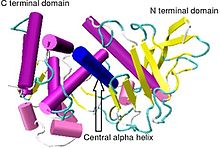Thermolysin
| Thermolysin | |||||||||
|---|---|---|---|---|---|---|---|---|---|

Crystallographic structure of Bacillus thermoproteolyticus thermolysin.
|
|||||||||
| Identifiers | |||||||||
| EC number | 3.4.24.27 | ||||||||
| CAS number | 9073-78-3 | ||||||||
| Databases | |||||||||
| IntEnz | IntEnz view | ||||||||
| BRENDA | BRENDA entry | ||||||||
| ExPASy | NiceZyme view | ||||||||
| KEGG | KEGG entry | ||||||||
| MetaCyc | metabolic pathway | ||||||||
| PRIAM | profile | ||||||||
| PDB structures | RCSB PDB PDBe PDBsum | ||||||||
|
|||||||||
| Search | |
|---|---|
| PMC | articles |
| PubMed | articles |
| NCBI | proteins |
Thermolysin (EC 3.4.24.27, Bacillus thermoproteolyticus neutral proteinase, thermoase, thermoase Y10, TLN) is a thermostable neutral metalloproteinase enzyme produced by the Gram-positive bacteria Bacillus thermoproteolyticus. It requires one zinc ion for enzyme activity and four calcium ions for structural stability. Thermolysin specifically catalyzes the hydrolysis of peptide bonds containing hydrophobic amino acids. However thermolysin is also widely used for peptide bond formation through the reverse reaction of hydrolysis. Thermolysin is the most stable member of a family of metalloproteinases produced by various Bacillus species. These enzymes are also termed 'neutral' proteinases or thermolysin -like proteinases (TLPs).
Like all bacterial extracellular proteases thermolysin is first synthesised by the bacterium as a pre-proenzyme. Thermolysin is synthesized as a pre-proenzyme consisting of a signal peptide 28 amino acids long, a pro-peptide 204 amino acids long and the mature enzyme itself 316 amino acids in length. The signal peptide acts as a signal for translocation of pre-prothermolysin to the bacterial cytoplasmic membrane. In the periplasm pre-prothermolysin is then processed into prothermolysin by a signal peptidase. The prosequence then acts as a molecular chaperone and leads to autocleavage of the peptide bond linking pro and mature sequences. The mature protein is then secreted into the extracellular medium.
...
Wikipedia
